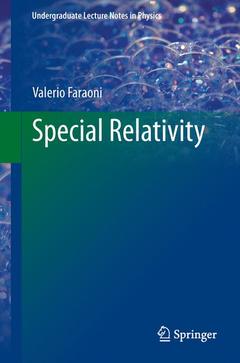Description
Special Relativity, 2014
Undergraduate Lecture Notes in Physics Series
Author: Faraoni Valerio
Language: English
304 p. · 15.5x23.5 cm · Paperback
Description
/li>Contents
/li>Biography
/li>Comment
/li>
This book offers an essential bridge between college-level introductions and advanced graduate-level books on special relativity.
It begins at an elementary level, presenting and discussing the basic concepts normally covered in college-level works, including the Lorentz transformation. Subsequent chapters introduce the four-dimensional worldview implied by the Lorentz transformations, mixing time and space coordinates, before continuing on to the formalism of tensors, a topic usually avoided in lower-level courses. The book?s second half addresses a number of essential points, including the concept of causality; the equivalence between mass and energy, including applications; relativistic optics; and measurements and matter in Minkowski space-time. The closing chapters focus on the energy-momentum tensor of a continuous distribution of mass-energy and its co-variant conservation; angular momentum; a discussion of the scalar field of perfect fluids and the Maxwell field; and general coordinates.
Every chapter is supplemented by a section with numerous exercises, allowing readers to practice the theory. These exercises constitute an essential part of the textbook, and the solutions to approximately half of them are provided in the appendix.
Fundamentals of Special Relativity.- Introduction.- The Principle of Relativity.- Groups—the Galilei group.- Galileian law of addition of velocities.- The lesson from electromagnetism.- The postulates of Special Relativity.- Consequences of the postulates.- Conclusion.- Problems.- The Lorentz transformation.- Introduction.- The Lorentz transformation.- Derivation of the Lorentz transformation.- Mathematical properties of the Lorentz transformation.- Absolute speed limit and causality.- Length contraction from the Lorentz transformation.- Time dilation from the Lorentz transformation.- Transformation of velocities and accelerations in Special Relativity.- Matrix representation of the Lorentz transformation.- The Lorentz group.- The Lorentz transformation as a rotation by an imaginary angle with imaginary time.- The GPS system.- Conclusion.- Problems.- The 4-dimensional world view.- Introduction.- The 4-dimensional world.- Spacetime diagrams.- Conclusion.- Problems.- The formalism of tensors.- Introduction.- Vectors and tensors.- Contravariant and covariant vectors.- Contravariant and covariant tensors.- Tensor algebra.- Tensor fields.- Index-free description of tensors.- The metric tensor.- The Levi-Civita symbol and tensor densities.- Conclusion.- Problems.- Tensors in Minkowski spacetime.- Introduction.- Vectors and tensors in Minkowski spacetime.- The Minkowski metric.- Scalar product and length of a vector in Minkowski spacetime.- Raising and lowering tensor indices.- Causal nature of 4-vectors.- Hypersurfaces.- Gauss’ theorem.- Conclusion.- Problems.- Relativistic mechanics.- Introduction.- Relativistic dynamics of massive particles.- The relativistic force.- Angular momentum of a particle.- Particle systems.- Conservation of mass-energy.- Conclusion.- Problems.- Relativistic optics.- Introduction.- Relativistic optics: null rays.- The drag effect.- The Doppler effect.- Aberration.- Relativistic beaming.- Visual appearance of extended objects.- Conclusion.- Problems.- Measurements in Minkowski spacetime.- Introduction.- Energy of a particle measured by an observer.- Frequency measured by an observer.- A more systematic treatment of measurement.- The 3+1 splitting.- Conclusion.- Problems.- Matter in Minkowski spacetime.- Introduction.- The energy-momentum tensor.- Covariant conservation.- Energy conditions.- Angular momentum.- Perfect fluids.- The scalar field.- The electromagnetic field.- Conclusion.- Problems.- Special Relativity in arbitrary coordinates.- Introduction.- The covariant derivative.- Spacetime curves and covariant derivative.- Physics in Minkowski spacetime revisited.- Conclusions.- Problems.- Solutions to selected problems.- References.- Index.
Serves as a textbook at intermediate level between college-level introductions and more advanced textbooks requiring many prerequisites
Includes topics that are not usually included in standard textbooks on special relativity such as, for example, the theory of measurement in Minkowski spacetime
Has a chapter devoted to modern applications of Special Relativity, such as GPS, PET scanners, and other medical instruments
Contains a section with numerous exercises to practice the theory in each chapter
Includes supplementary material: sn.pub/extras
These books may interest you

Cosmology in Scalar-Tensor Gravity 158.24 €



